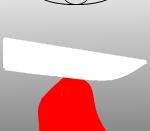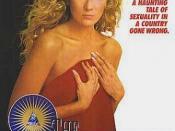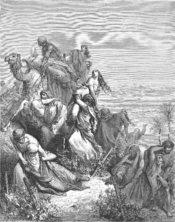The Handmaid's Tale by Margaret Atwood is a futuristic slow-paced thriller that draws from Biblical and political sources to convey its implications. The depth of its message and the language used is fairly clear, but what is it that makes the dystopia so convincing? The story of the Handmaid takes places in the near future, in the city of Gilead. The dystopia is situated in what is currently Cambridge, Massachusetts. Created after a military coup that resulted in the overthrow of the government by an elite group of individuals, Gilead is a brutal regime whose laws are based on the Old Testament. This is can be determined from the name itself, it being a Biblical reference to an old city in the Middle East.
The population is forced to serve the state and is classified into roles. These roles include the Commanders, the Wives, the Aunts, the Handmaids, the Marthas, as well as the Eyes and Guardians amongst others.
This grim, gothic, futuristic world serves to keep the human population steady and controlled, and its existence revolves around the issue of reproduction. The fertility rate has gone down and it is believed that there are relatively few women left that can give birth. These are seeked out and gathered (being now a "national resource"). They are given the role of the handmaid and are "issued" to those Commanders that require children, and are recycled when their services end.
Fertility is only considered in women, and there is "no such thing" as a sterile man. This is not true in actual fact, and amongst the many undercurrent and side stories running throughout the novel, we learn that there are contrarily many men that are infertile. This fact illustrates the patriarchal regime that controls Gilead - and emphasises the male dominance. Despite the fact that some men are contributing to the declining birth rate (if their handmaid does not produce a child then they eventually go to the colonies, where they can no longer reproduce), they remain in control as the leaders in the regime. It is interesting to note that this dystopian reality was prophesised by Serena Joy, one of the direct victims of the change, and she as well as all the other women in Gilead are stripped of their rights.
Although the setting seems futuristic, there is realism in the situation as the purpose of the Gileadan society hits closer to home than we first realise. That it is set in a time close to ours may be enough to make us feel the immediateness of the issues, but the fact that it deals with a matter that is not unrealistic, namely the control of a population by a power-hungry elite force, does in fact make us realise that this is not mere science fiction.
The key philosophy of Gilead is that "eggs are broken", and not everyone benefits. One can take these eggs as symbolising the freedom of the women, and other minority groups whose lives have been "broken" - such as the homosexuals and the elderly.
Society is bent on the oppression of the people, and the public are kept ignorant of the happenings around the world. We know from various sources such as the television that Serena Joy watches, and the Historical Notes at the end the there are wars being fought on the borders of Gilead, although we are never told between whom. The government withholds information from the public, restricting their choice of TV and radio channels, as well as literary sources. Schools have closed, as have normal areas, which before would have given jobs to people. The people are as a result illiterate, and/or refused the right to possession of any piece of literature - in either case they are unable to read, or watch television. In fact only articles related to the Bible are available freely in these media, one example is the Soul Scrolls. Propaganda is used to convey images ("who knows if any of it is true?' -Offred) to the public that are desired by the government ("They only show us victories, never defeats" -Offred), and the people are told "what they long to believe", the most prominent image being that which portrays a positive reflection of them and that all is well ("who wants bad news?" -Offred). But when Offred is given a chance to watch television with Serena Joy, she takes in every detail, "hoping to be able to read beneath it", and information in any form in hungered for as, in Offred's words, "any news, now, is better than none".
The brutal regime of Gilead is such that people fear the "Eyes" and the Guardians, and breaking of the rules result in their arrest, or even worse, as in the case of Moira and Dolores at the Red Centre, torture. Aunts claim "scriptural precedent" to hit, which is a grim indication of the twisting and perversion of Biblical derivatives. The original idea of surrogate mothers as referred to in Genesis itself has been twisted to form the sole function of Gilead.
One feature of Gilead is the Wall. On this wall traitors and those who commit crimes punishable by death are hung here. Offred sees a priest hung here at one point, his offence being that he was homosexual, committing what is referred to by the Gileadan as "gender treachery". This is another reference to the Bible, since it is therein declared that homosexuality is a sin. The result of all this is that everyone lives in a constant state of fear and uncertainty.
Gilead's rules are illustrated in their use of colour to distinguish everything and to segregate groups, and this strips the groups of certain rights (no one has "all of anything") - in the handmaids' case, almost all of them. The colours chosen for the different roles are symbolic and reflect the classes they signify. The handmaids wear the colour red, which can be regarded as being symbolic of blood, of purity and of fertility simply because their role involves these three things. The Marthas, or servants, wear green, and there is reference to "surgeons' gowns". The Commanders' Wives wear a more masculine blue, and this emphasises their reputation for "coldness" and hostility, and especially sterility. The Commanders, being at the top of the class hierarchy, wear black, which is very clear in its significance of power, and "prestige".
Aunt Lydia mentions "camaraderie among women", which is ironic since this is the exact opposite of the truth. In reality women are separated and classified. In fact it is more than this, they are rivals in their own eyes, the Wives look down on the handmaids, so do the Marthas. And back at the Red Centre the handmaids didn't trust one another, some afraid of the "believers" amongst them. Society has been reduced to a state where there is nobody in whom one can trust.
But the reaction of the stronger ones is that they resist and find their own way out. At the Red Centre the girls are refused the right to interact with each other except in strict condition, but they display their desire to reach out and touch each other, to connect. Across this "space" that threatens to separate them, they still hold on to each other and continue to communicate, lip reading ("whispering without sound") when all else fails. This is illustrative of the desire to unite and form an alliance, something that does not end upon their departure from the Red Centre. For even separated and isolated in the wilderness of Gilead, there are connections between them (a "grapevine") and an "underground of sorts".
The house of the Commander that Offred serves is a good example of the hostility of this new world. The sitting room in which Offred must endure recitations of verse by the Commander is claustrophobic and turns her into "a piece of furniture", with Serena Joy using her to get into and out of her chair. Atwood creates an extremely hostile environment through use of carefully selected words. Offred notices the "sterility" of the room, it being "artificial" and housing images of luxury, which has been created by money "frozen" and "hardened" into the items of the room. The use of hard, brittle words such as these give an effect of a tense atmosphere in which there exist artificial and symmetrical dimensions that are reflective of Gilead and not of Nature. And the smell of perfume, which was but another feature of the room, is soon "sickening". This causes the claustrophobic effect and the feeling of entrapment. This last effect is also created by the revealing reference to a nursery rhyme depicting the encounter between the Spider and the Fly. One does not need to be familiar with the rhyme to understand Offred's feelings.
We are introduced to a nameless heroine at the start of the book. We later get to know her as Offred, and we learn of her life as a handmaid, as well as some of the life she lived in "the time before".
Aunt Lydia at the Red Centre refers to the role of the handmaids as a "role of honour", earning "respect" of the other members of society, and asserts that they live a "pampered" life for which they must be grateful, which is ironic since one couldn't make a wild guess of this from the way they are really treated. It is strange, because at one point Offred is treated like the very chicken she bought at the meat store, when being examined by the doctor. The repetition of the word "prodding" in both places brings to mind the uncomfortable process she has to endure.
The job of the handmaids (whom she calls "carriers") is referred to as a "business transaction" by none other than Serena Joy, which is none too surprising. In her eyes she does not see it - or does not want to see it - as any more than that.
The Rachel and Leah Woman's Re-education Centre, called the Red Centre by the handmaids, has been established to gather fertile women and teach them the rules of the New World. The young handmaids are introduced to the harsh reality of the system, and brought into the world of Gilead.
The Gileadan society is bent on ridding the old way of life, and handmaids are given these lessons in the Testifying periods at the Red Centre.
Atwood uses imagery and metaphors to illustrate the effects of society on the central character.
One instance when Offred is helping Serena Joy in her knitting causes Offred to break out in paranoia, and she feels like she is "leashed", and "manacled" like an animal. The sense of pressure and claustrophobia is delivered with this event, and Atwood successfully realises us the extent of this pressure.
Offred's role and the oppression of society have caused her to regard her own body in a different light, to the extent that she has separated it from her mind, and they both co-exist as independent entities. In her mind, she is a "cloud", a mist of consciousness that is no longer real, and that hangs over her body, which is "the shape of a pear" and is "glowing red".
And Gilead's pressure does not seem to stop her depression at this point. The fact that she compares her life to those of animals that are brought up for single purposes (such as pigs for meat) is indicative of the status she regards herself to have. She simplifies her life as involving being "well fed and brushed", just to produce good offspring.
The matter of her name is something that emphasises the effects on Offred. Her real name - which we eventually work out to be June - and which she "cherishes" and "treasures" being denied of her, she clings to it like an "amulet", or "charm". A name to us would seem so trivial an item, but for Offred it has become something to hold onto, a link to her past which she won't let go just for the sake of being able to "dig it up" later.
The oppression comes also to the extent that the handmaids consider suicide as "escape", and the Commanders end up having to remove any "cutting edge", or "anything you could tie a rope to".
The novel is written in the first person, so we are given a front seat experience of Offred's feelings and recollections. It is understandable why Atwood had chosen this form of narration, we can reason that it is the best way to receive this information. But we later learn that the story was in fact aurally conveyed, and was documented later by a third party. This helps us understand the nature of Offred's rather scattered thoughts, but this gives us a sense of cohesion, contrary to one's first beliefs. One would think that the sporadic narrative causes confusion, but Atwood instead creates a sense of continuity, as the thoughts flow into each other.
The thoughts and recollections are triggered by events that happen in the present. As Offred goes through her daily routine, different things that happen cause Offred to start a chain of thoughts. The narrative is hence a continuity of events and thoughts, at times even confusing to judge (whether happening in the present or past). These shifts between different time frames are done well by Atwood's successful use of juxtaposition.
The descriptions of past and present allow us to compare them, and it makes Gilead seem even worse than it is.
And the pace of the thoughts and events change throughout, depending on the matter on hand. The beginning of the novel, for instance, is quite slow paced, the time marked by the pendulum of the hallway clock, and the sound of the feet on the stairs outside Offred's room. The pace is slowed down in many places, especially in significant areas in the book such as chapter 2 and 13, and this is done by excessive detail - in the surroundings as well as in her own mind. In chapter 2 Offred goes about to explain her daily routine, and it is done in no hurry either. There is painfully slow progress as she describes her surroundings and emotions, while shifting back and forth between thoughts. This emphasises the nature of Offred's life, for she lives in a state slow monotony. Chapter 13 sees Offred napping, and recalling many images, that are a mix of past and present.
While the language remains fairly subtle over the majority of the novel, the build up to the Ceremony, which involves hints and foreshadows until the moment in chapter 16, the language in the chapter itself is quite direct. It is graphic and explicit to the end of shocking, and the scene is made blunter by the rather shocking language used (ie., the profanity). The repetition of verbs and other words convey the impression of speed, action and rigorous movement - none of which are regularly associated with making love. The overall atmosphere created then is a rather unpleasant. The situation is ridiculed by Offred, it is recalled in a cynical tone, with mocking and sarcastic comments. Most of these are in the form of rhetoric questions, and some are ironic ("but isn't this everyone's wet dream, two women at once?"). The anti-sensuous adjectives used are unpleasant ("sagging", "heavy", "downward") and convey the true meaning of the situation. The sentences are short and the chapter itself in brief. And all this creates an extremely negative picture from which she "detaches" herself.
And the shock of this anticlimax, after all the build-up, leads to our understanding of the sinister undercurrents in Gilead. That the ceremony itself is not so big a deal as one would believe from the importance given to it by Gilead says something about its hypocrisy.
All this slowly establishes a sympathy for Offred. We come across many characters in the story, from the lesbian activist Moira to the victim of the system Janine, but Atwood is careful to place their characters on the extreme side; Moira is quite outrageous in her ways (with her dress, which always is aimed "to be eccentric", and her actions such when she escapes from the Red Centre - always non-conformist), while Janine becomes the inevitable enemy to Offred through her conversion and attitude (being a victim of society she is a conformist, and sucks up to the Aunts). Offred basically is a "wimp", the title courtesy of Moira. But our sympathies remain with Offred for many reasons. One, I would hope to be the most important, that Offred represents mother and daughter in a system where this relationship no longer exists. Offred is one of the early handmaids that lived before Gilead started, so she has had experiences of a life very much different from now. She lived a life where there was love, something that is missing from the present time. "Love?" asks the Commander, "it's not the point." Offred, initially the nameless heroine, is someone we can relate to. The lack of a name reflects the effects of society on the individual - they become insignificant - and we sympathise with her because we want her regain her identity as an individual. And she can do this, and is a good heroine simply for the fact that she develops. And for the better, in our opinion. We naturally want her to beat the system, and succeed in her attempts to find love again. The reason we believe in her is because of her capacity for development. From accepting to mentally resisting to physically resisting, Offred is constantly developing while those around her remain in a state of static confusion. Beginning with just passive comments of her dislike of the new system, she then develops a consistently resisting attitude towards the world around her (taking her "time out" at night and returning to the past whenever she can). At this point it is enough for the people around her such as Moira (in whose presence she feels "safer") to play their parts. Considering weapons such as Serena Joy's shears in the garden and knives in the kitchen shows the next development in her mind, which is leading to her physical involvement in her emotions and desires. Since Offred has Moira to inspire her, it is too late by the time she discovers of Moira's submission, for she has already gained momentum.
Images of flowers are consistent throughout the text ("where would we be without them?" -Offred), but their connotations vary with the context. However what is same about each reference is that they enhance the reader's understanding of the different themes such as the role of the handmaids as well as that of the Wives.
In chapter 3 we are introduced to the garden of Serena Joy, her "domain" where tulips "spilling out colours" of dark crimson, and irises "rising beautiful and cool" grow. It symbolises the "fullness" of fertility, which is a theme that involves growing.
The symbolism of the flowers in Serena Joy's garden is expanded in chapter 25, when Offred crosses it and notices the former cutting them. The idea of Serena Joy cutting off the "genitialia of flowers", is symbolic of fertility, that which she does not have.
And the flowers are used as a parallel to Offred's status, and her frame of mind. She finds the will of the flowers, "bursting upwards" analogous to the mental resistance in her own mind, and hint to us the uprising of those oppressed, or "silenced", and how they "clamour to be heard" and are similar to the rebellious movement in Gilead itself. This point emphasises the oppression of Gilead, and the attitudes of the oppressed, as well as the fact that Gilead's sinister and twisted reality is reflected in all living things around Offred.
The colours of the garden, described in chapter 25, are very clearly different to those to which we have by now become very accustomed to: red, green, blue and black. The colours of society are very plain and distinct, and they are illustrative of Gilead's system, constantly reminding us of the strict rules. But here in the garden, the colours are different and of a completely other nature. Colours like light mauve and velvet and purple give a different image, and we see the garden as a place full of life, which "breathes" and supports living things like only the handmaids can know. This is a sharp contrast to the grim dark reality of artificial Gilead, and suggests hope not only in Offred, who notices these signs, but also in all the lives that have been affected by Gilead.
The other theme illustrated by imagery throughout the novel is that of children, as Gilead's whole purpose revolves around the production of children.
Since the loss of her own child is a matter of great importance to her, Offred has her own images of children - which emphasise the horror of a mother losing her child. She also sees such imagery in the environment around her. Some things seemingly trivial such as men's urinals, which she saw in the Red Centre, are in fact symbolic, and in her eyes "babies' coffins".
The image of children is imposed on the handmaids themselves, they are taught and treated like children at the Red Centre. This is also the cause of Offred's own images of children. Chapter 13 includes a passage that is a recollection of Offred's past when the handmaids are Testifying. The handmaids learn by reciting verses and chanting the lessons given by the Aunts, and have to raise their hands to ask of something from the Aunts. This is a very childlike way of learning considering the age of the handmaids, and they are treated like this to the extent that they are prisoners. They are helpless to the rules and discipline of the Aunts. This is illustrated in the passage by the unfortunate episode when Dolores is forced to wet the floor just because she is not given permission to go to the bathroom. But the handmaids' reaction to it is childish behaviour, an example of this is the way they chant "Crybaby" of their own accord when jeering at Janine in the same lesson. Some, like Janine herself, become part of the system.
The society of Gilead is brutal but evidently realistic, as we can consider the factors leading to it are largely political. However, factors such as a nuclear holocaust causing or at least contributing to a declining birth rate of Caucasians (as well as the decline itself) are also issues that are not foreign to us in today's society. We are given a terrifying moral prophecy which by no means is taken so seriously as to be considered the future, but is realistic enough that we consider the implications. The purpose of the historical notes may have been to reveal many parts of the history of Gilead, but it certainly conveyed the message, that we must learn from history, which is not an unknown philosophy. That we don't is not the point, but that we try to understand and learn from it is most probably what Margaret Atwood was trying to convey in the end.





